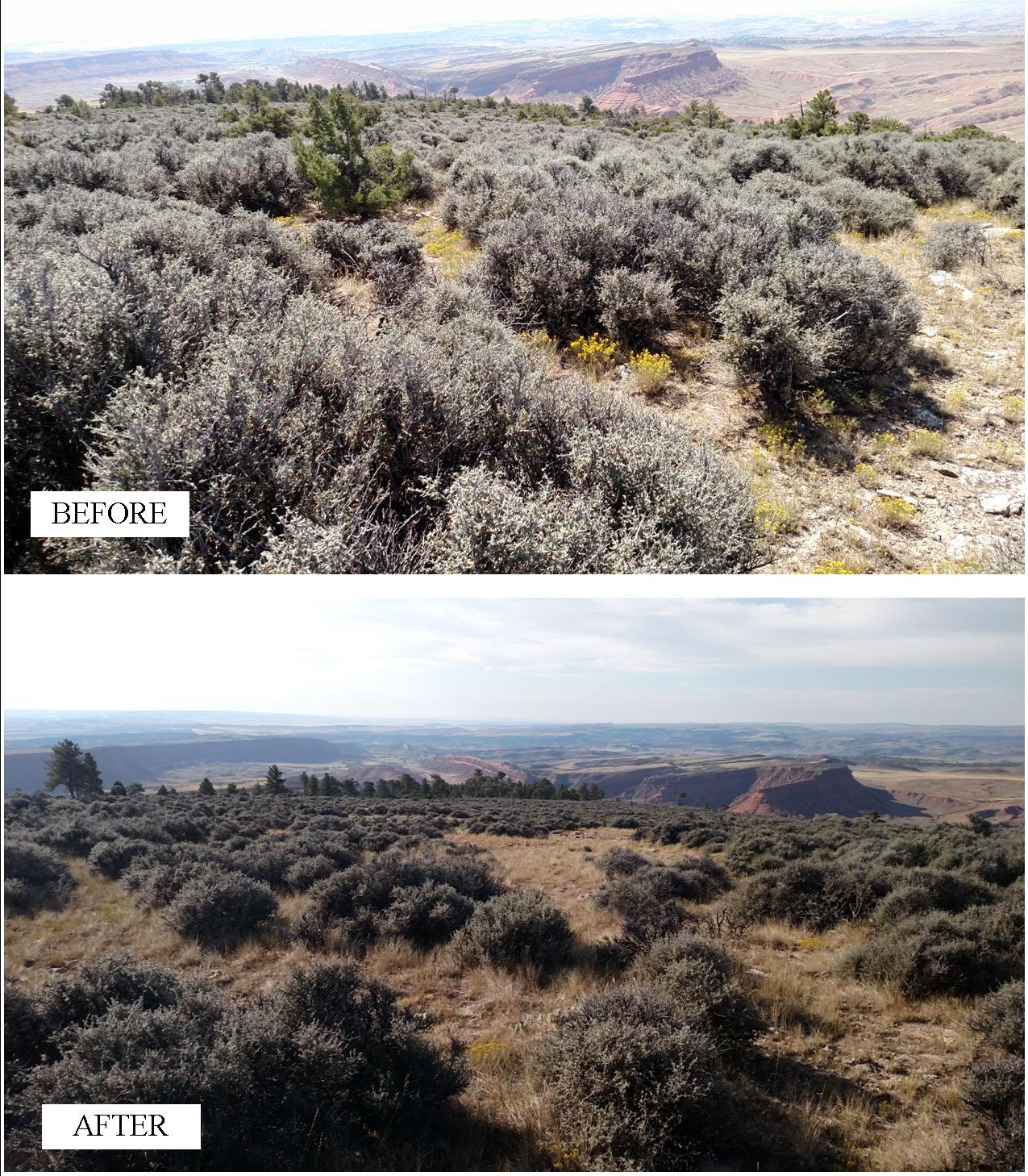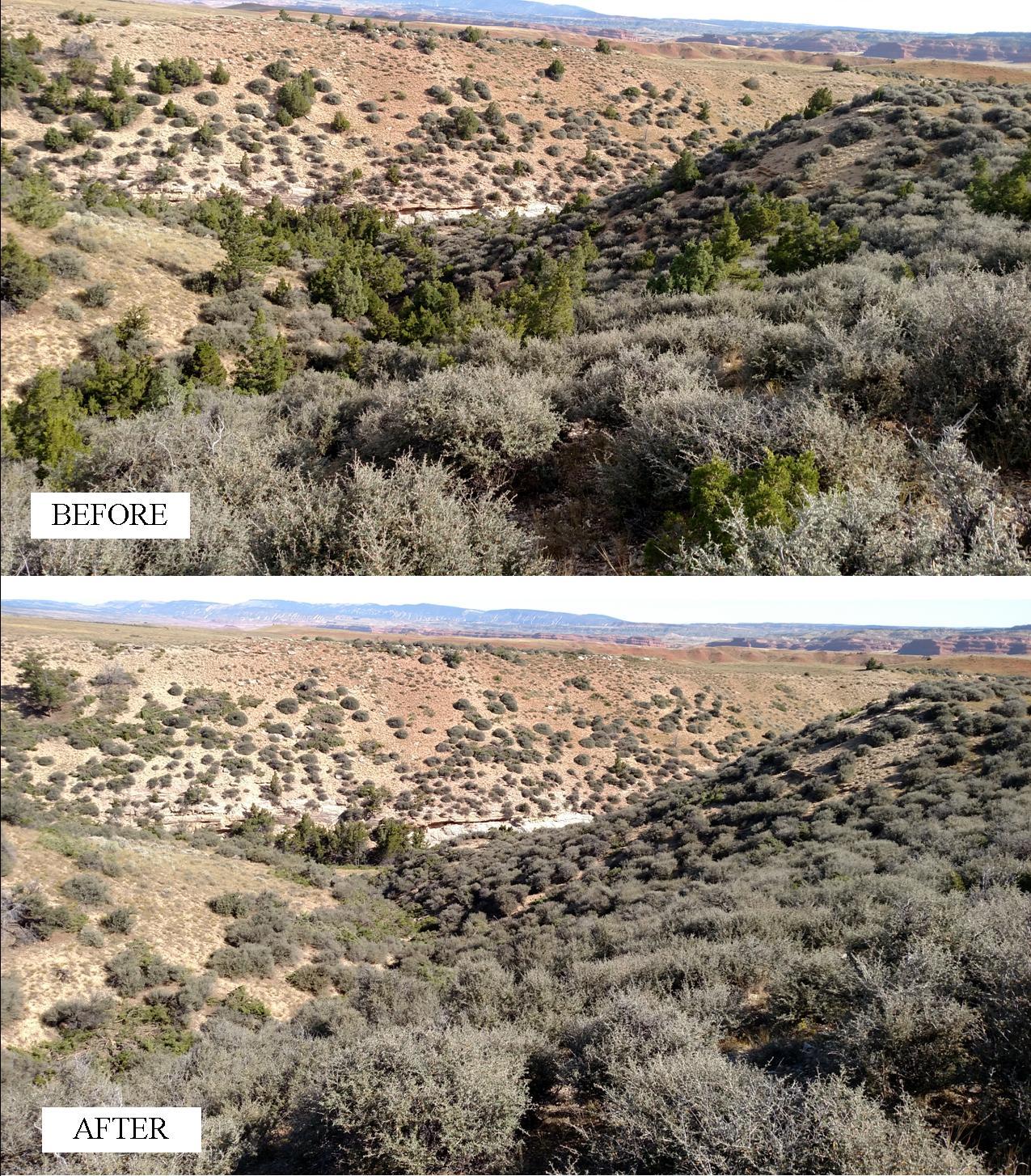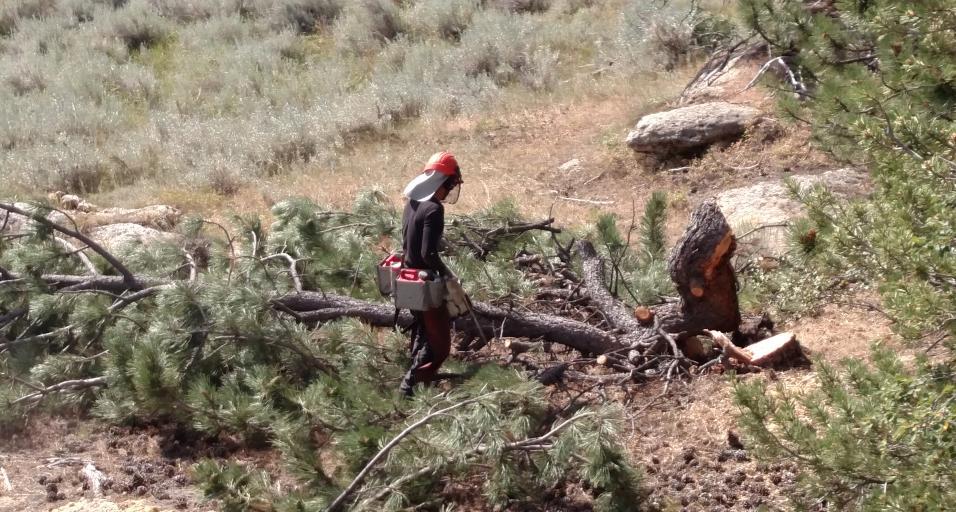Habitat treatments completed near Kaycee
By Todd Caltrider, Sheridan Region Terrestrial Habitat Biologist
Wyoming Game and Fish recently completed phase one of a habitat project in the southern Bighorn Mountains that will provide benefits to the Upper Powder River Mule Deer Herd, one of the focal herds in the WGFD Mule Deer Initiative.
The mule deer population in the Upper Powder River herd unit has been below objective for several years. To improve mule deer numbers, Game and Fish has focused on implementing projects to improve mule deer habitat.
The Southern Big Horn Mountains Curl-leaf Mahogany Restoration Project is a long term habitat project initiated by the WGFD and the Bureau of Land Management in the Poker Creek and Gardner Mountain areas near Kaycee.
The project began in 2011 as a response to the 2006 Outlaw Cave fire, which burned 815 acres of curl-leaf mountain mahogany stands. Curl-leaf mountain mahogany is important winter forage for mule deer. Protecting stands from catastrophic wildfires is critical to sustaining winter deer habitat.
Curl-leaf mountain mahogany, an evergreen shrub that does not burn readily, grows in shallow, gravelly soils, which are typically not very productive and therefore do not accumulate large loads of flammable fuels. Although wildfire is a natural part of the ecosystem, increased conifer (Ponderosa pine, Limber pine, and Rocky Mountain juniper) encroachment into curl-leaf mountain mahogany stands over the past 50 years has boosted the fuel load and increases the potential for catastrophic, high-intensity wildfires. These types of fires, such as the Outlaw Cave fire, can kill mahogany stands.
Following the fire, regeneration of curl-leaf mountain mahogany has occurred, but it is sparse compared to the original stands. It is a slow growing plant species and we do not expect these burned stands to come back to their original density and size for at least another 100 years.
In addition to increasing fuel loads, encroaching conifers cast shade on mahogany stands and compete for water. Curl-leaf mountain mahogany is not a shade tolerant species, and if left unchecked, conifers will eventually shade the plants and kill them.
Since 2011, WGFD and the BLM have treated 3,542 acres of mountain mahogany habitat in the southern Bighorn Mountains by removing conifers. Conifers have been mechanically removed by hand crews using chainsaws, with cut conifers then lopped and scattered. Most of the acreage treated is located in the Middle Fork Management Area (BLM land), the WGFD’s Ed O. Taylor Wildlife Habitat Management Area and private land along the face of the Bighorns north of the Middle Fork Powder River to Beaver Creek.
In 2018 and 2019, 870 acres of mahogany stands in the Poker Creek drainage, at the southern end of Gardner Mountain and the lower Slip Road had conifers removed. All these areas are located in crucial mule deer winter range.
Funding for these two projects was provided by the Wyoming Game and Fish Mule Deer Initiative, Bureau of Land Management, Wyoming Governor's Big Game License Coalition, Wyoming Sportsman's Group and the Wyoming Wildlife and Natural Resource Trust.
Phase two of the project, involving further conifer removal near EK Mountain, will begin in 2020.


Wyoming Game and Fish recently completed phase one of a habitat project in the southern Bighorn Mountains that will provide benefits to the Upper Powder River Mule Deer Herd, one of the focal herds in the WGFD Mule Deer Initiative.
The mule deer population in the Upper Powder River herd unit has been below objective for several years. To improve mule deer numbers, Game and Fish has focused on implementing projects to improve mule deer habitat.
The Southern Big Horn Mountains Curl-leaf Mahogany Restoration Project is a long term habitat project initiated by the WGFD and the Bureau of Land Management in the Poker Creek and Gardner Mountain areas near Kaycee.
The project began in 2011 as a response to the 2006 Outlaw Cave fire, which burned 815 acres of curl-leaf mountain mahogany stands. Curl-leaf mountain mahogany is important winter forage for mule deer. Protecting stands from catastrophic wildfires is critical to sustaining winter deer habitat.
Curl-leaf mountain mahogany, an evergreen shrub that does not burn readily, grows in shallow, gravelly soils, which are typically not very productive and therefore do not accumulate large loads of flammable fuels. Although wildfire is a natural part of the ecosystem, increased conifer (Ponderosa pine, Limber pine, and Rocky Mountain juniper) encroachment into curl-leaf mountain mahogany stands over the past 50 years has boosted the fuel load and increases the potential for catastrophic, high-intensity wildfires. These types of fires, such as the Outlaw Cave fire, can kill mahogany stands.
Following the fire, regeneration of curl-leaf mountain mahogany has occurred, but it is sparse compared to the original stands. It is a slow growing plant species and we do not expect these burned stands to come back to their original density and size for at least another 100 years.
In addition to increasing fuel loads, encroaching conifers cast shade on mahogany stands and compete for water. Curl-leaf mountain mahogany is not a shade tolerant species, and if left unchecked, conifers will eventually shade the plants and kill them.
Since 2011, WGFD and the BLM have treated 3,542 acres of mountain mahogany habitat in the southern Bighorn Mountains by removing conifers. Conifers have been mechanically removed by hand crews using chainsaws, with cut conifers then lopped and scattered. Most of the acreage treated is located in the Middle Fork Management Area (BLM land), the WGFD’s Ed O. Taylor Wildlife Habitat Management Area and private land along the face of the Bighorns north of the Middle Fork Powder River to Beaver Creek.
In 2018 and 2019, 870 acres of mahogany stands in the Poker Creek drainage, at the southern end of Gardner Mountain and the lower Slip Road had conifers removed. All these areas are located in crucial mule deer winter range.
Funding for these two projects was provided by the Wyoming Game and Fish Mule Deer Initiative, Bureau of Land Management, Wyoming Governor's Big Game License Coalition, Wyoming Sportsman's Group and the Wyoming Wildlife and Natural Resource Trust.
Phase two of the project, involving further conifer removal near EK Mountain, will begin in 2020.


3076727418




